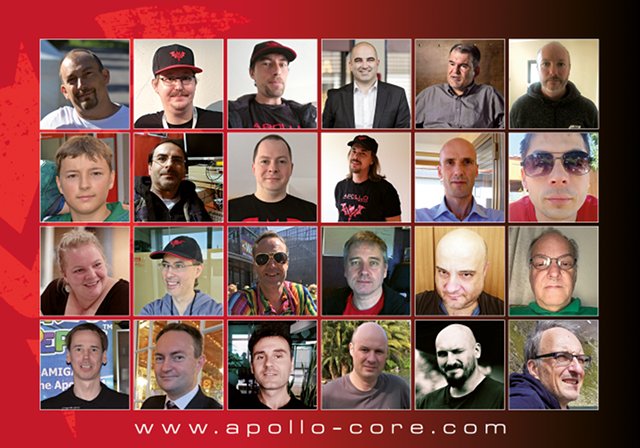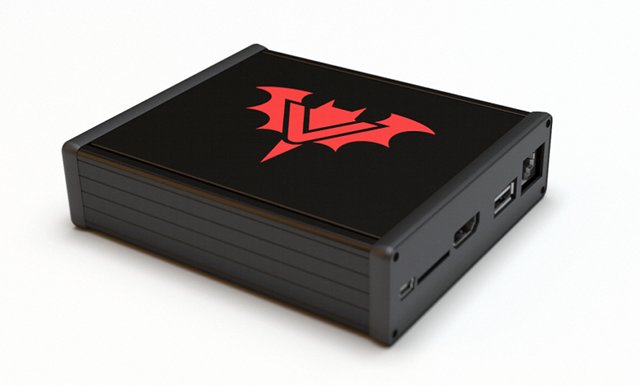| Home/BOING/BOING #3/Interview of Apollo Team | Last update: 2024-12-25 |
|
|
|
|
About / News / Store / Contact us You obviously already know the Apollo Team, including their Vampire accelerators cards for Amiga Computers. Some members of the team answered our questions... The interview was initially published in BOING French magazine issue #3 (December, 2021). Thanks to our partner amiga-news.de, it's also available in German. TEAM
Hello to the whole team ! Where does the name of your company come from, "Apollo" ? When was it founded ? Miri : Gunnar wanted a memorable name that could be pronounced worldwide. What is the main objective of Apollo Team ? Bartek : Fully revive the Amiga. As we remember Amiga was sold in millions of units. We want Amiga back in every home. Do some people work full time for the Apollo Team ? Or does everyone have a "day job" ? Miri : Gunnar and I work full time for the project. All the rest do volunteer their spare time as they life situation allows and every team member is giving as much as he can. Quite often we can see many of the Team members working on the project on a daily basis. Igor Majstorovic, present from the start, recently left the Apollo Team. What is the reason ? How is he ? Bartek : Igor joined the Team in 2013 and the Project started in 2007 with NATAMI. It was a great time with Igor and we appreciate his work a lot. Igor left for personal reasons. We wish him all the best, but I am sure he will appreciate if you also ask him directly. Thomas (Hirsh) replaced Igor in the team: is he a new member of the team ? Gunnar : Thomas can hardly be called a "new" member, simply because it is Thomas who started all of this in 2007, when everything started with NATAMI. So he is a founding member of the project and our Team. Do you plan to recruit new people ? Miri : We are always open to cooperate with passionate Amiga fans. This project is so huge, that every hand on deck is need to revive the Amiga. For sure especially developers who are interested to improve AROS are welcome. But our daytime is full of other stuff like testing, graphics, promo videos, webshop, developing new Amiga games, and so on and so force so feel free to help. You own several websites (apollo-accelerators.com, apollo-core.com, apollo-computer.com, ...): do you plan to merge everything into a single website ? Miri : Miri: Yes we plan and we already try to clean up and bring structure to the pages. The basic idea is that we will have two pages: VAMPIRE
Can you introduce us to the Vampire V4 ? Gunnar : The Standalone version, known simply as the V4, is a new Amiga-compatible model. Who chose the name "Vampire" for your FPGA ? What is the story behind this name ? Bartek : Igor invented the name Vampire for his series of accelerators. The region of Europe where Igor comes from is world famous for Transylvania, where the gothic fortress associated with the legendary Dracula is located. So the vampire is probably the only Bosnian word known to the rest of the world. I understand that the Vampire V4 are produced in Germany whereas in general, this kind of material is produced in China. In addition, the consumption (2 watts) is very low. Is it an environmental will ? Bartek : We believe in a world where excellent hardware can be produced locally and we do not think everything needs to be coming from just one region of the planet. The low power consumption levels for the V4 were carefully chosen, as we do care about our tiny blue dot and future of our kids and grandchildren, who also deserve the right to enjoy clean and green environment. Could the pandemic create supply and therefore production problems for you ? Miri : We produce our PCB in Germany and the solder house is also located near Stuttgart. We buy our chips directly from Intel and not on some chinese markets. Moreover gladly Gunnar was so smart buy two years ago all needed parts for three years, because he was afraid of what happened know. That was the best step, because even Intel currently has a delay of two years for the FPGA. One of the big names in the Amiga, Dave Haynie, is mentioned in one of your adverts. How did meet him ? Are you regurlarly in touch with him ? Does he give you advices ? Gunnar : After long time email contact, we finally met Dave at the Amiga34 in Neuss. Dave followed our project for many years and he is a fan of the developments and the reviving work for the Amiga. He loves that we finish the original plan of the Amiga developers. Was it hard to implement AMMX technology into the FPGA, which allows several data to be handled simultaneously in order to speed up some processes/software ? Gunnar : Yes, adding the AMMX instruction enhancement was definitely one of the biggest tasks we decided to undertake, but it was worth it. The AMMX instructions set enhancement was carefully designed with feedback from game programmers, applications and demo coders and it is optimized to highly improve the performance of games, graphics and Video processing. We have placed a main focus on ensuring that the architecture is easy to understand and coder-friendly. To achieve this goal we did a lot of brainstorming, we wrote tones of test cases, discussed and evaluated. Does the software developed for the Vampire take advantage of this technology by default or do programmers have to use specific APIs to be able to use it ? Gunnar : Many of the features of the 68080 CPU, like improved branch prediction, memory streaming and instruction fusing, work automatically and also enhance old programs. The AMMX features need of course be used by the coder directly. The Programmers can use AMMXinstrutions without an API, you can use AMMX instructions directly and easyly in the code, the same way a programmer uses FPU instructions. Can developers take advantage of this technology also under AmigaOS 3.2 (and not only under ApolloOS) ? Gunnar : Of course, any 68080 equipped Amiga is capable of processing AMMX instructions. Do you think that one day we will be able to see in a fluid way a video in 720p on Vampire V4 ? Gunnar : The video playback capability of Riva is already quite optimized, today DVD like resolutions can be played fully smoothly. 720p is out of the scope of FPGA based. OPERATING SYSTEMS
It seems that the first V4s were delivered with AmigaOS 3.1 and the agreement of Amiga Corporation (Cloanto). Can you tell us more about this? How did the negotiations go ? Gunnar : Igor shipped the V2 accelerator line with the Cloanto ROM. Mike is responding very positively to our project and decided to contribute us with as many ROM/OS licenses as possible, which was really a good solution for the accelerator line. Due to the years of litigation, which recently resurfaced again, Cloanto was unable to serve us with more license and it was also not clear, in which direction the "lawsuit jorney" would go.The V4 Standalone is an important step to revive the Amiga and to ensure the success of that product we want to have a reliable solution, which is legal and lasts for the long run. So we need a legal and future oriented OS solution. After the Amiga fair A34 in Neuss, where we sold the first 30 units of the Standalone, we switched to AROS, which was the best alternative at that time. That was in October 2019, since that time the Apollo Team is working day by day to debug and polish AROS/ ApollOS, with the goal to have one day a even better. When did you decide to stop including AmigaOS 3.1 with Vampire V4 and replace it with ApolloOS ? Was this decision easy to make ? Did everyone at Apollo Team agree? Miri : No that was really not easy, it was maybe one of the hardest decisions for the Team. We are all maximum passionate Amigafans and one part we all love about the Amiga is for sure this wonderful Amiga OS. So in first step it was Gunnar who drove this decision and you can believe that it costs hours of discussion and best persuasion to go where we are today. Unfortunately there were some team members who didn't want to go this route and who are today no longer part of the team. We very much regret this but it is important to stand together at that significant point. Can you introduce us to ApolloOS, the system now delivered with the Vampire V4 ? Bartek : At the moment is probably the most advanced distribution you can use on your Amiga. It enables you to surf the internet, play new games and watch smooth videos out-of-the-box. It saves you tremendous amount of time of configuring the OS yourself and search and download all the files necessary to have a modern operating system. It seems that since R7, Directory Opus Magellan has been replaced by Wanderer as the ApolloOS office. What reasons led you to make this choice ? Gunnar : Most of the users we used to use the regular Workbench and do not know Directory Opus well. Dopus does many things differently than good, old known Workbench. And this led to confusion of many of our beloved fan base. So we decided to improve their experience and switch to Wanderer, simply because it offers experience much more closer to the original desktop they remember than such an advanced desktop replacement as Magellan. How do you evaluate ApolloOS today compared to AmigaOS 3.1 ? 3.2 ? 4.1 ? MorphOS ? Gunnar : The ApolloOS greatest advantage lies in its open-source nature, which is not the case in any other OS mentioned. We have the opinion that one of the main spirits from Amiga and Commodore was to provide not only excellent documentation but even commented ROM listings and sources with the goal to enable Amiga community to build their own Kickstart versions and to empower them. What do you think are the areas for improvement of ApolloOS ? Gunnar : ApolloOS is today out of the box a real proper solution. The last year made a huge step forward. ApolloOS did get much faster, compatibility to legacy software improved a lot and new features and improvements were added. In many areas like for example Disk performance ApolloOS is significantly faster now than Amiga OS. We know the games "Jake and Peppy", "Apollo-Blocks" and "Apollo Crown". Are there any other ApolloOS specific game projects or applications ? Gunnar : There are hundreds of game ideas in our mind and we would love to have more manpower to implement all this immediately ;). There are some games in the row waiting to be finished, one is called "Lucys Den" which is a two player Arcade game remake with excellent truecolor GFX and 16bit sound. We also started work on a Deluxe Remake of the well known Amiga shooter Menace. We are also working on now game ports like for example Command and Conquer. Do you think one day you will be able to distribute the AmigaOS 3.2 preinstalled on the Vampire V4 ? And do you want it ? Gunnar :We believe, that in the long run, the monopolistic concept of companies like Amiga inc, hyperion or many others, is not in the interest of Amiga community. We want to revive the Amiga! The past Amiga history of the last 25 years has shown, that greedy, controlling, and power obsessed Companies do not follow this goal, they damage the Amiga and the beloved platform. FUTURE
Can you tell us a little more about the new FireBird and IceDrake accelerator cards ? Miri : The FIREBIRD is the new accelerator for Amiga 500/ 1000/ 2000 and the ICEDRAKE is the new accelerator for Amiga 1200. Our main goal is to revive the Amiga and in order to achieve this goal, it is as important to bring new life into the "old" beloved Amigas as to provide new Amigas, such as V4 Standalone. So the new accelerator come s with a bunch of great features: AGA chipset, Truecolor Video out, 16bit Audio, 2x IDE ports for CF and CD-ROM, 100 MBit Ethernet and USB Joypad/CD32 support. Along with SD card port and real-time clock. Are they already available for sale ? Miri : Yes, the Firebird is already available for sale in our new shop (www.apollo-computer.com). Of the Icedrake we currently have the first cards for the team, the official sales of the Icedrake is planned for the beginning of 2022. What about the people who ordered Vampire V2 accelerator cards but didn't receive them ? Miri : These customers are enrolled to the new V4 offer and can get V4 accelerators in a priority queue. Will they receive one or will they automatically get one of the two new accelerator cards ? Miri : No the customers have the free choice to decide whether they want this new cards or not. But we produce in high quantity so everybody will be served. You have defined an accurate roadmap for the Vampire V4 (one update per quarter until reaching R13). Will Igor's leaving or the release of the new accelerator cards can change this schedule ? Gunnar : The workload, especially with the bringing up of the accelerator cards, is really high and we have enough to do. :-) So far we have been able to adhere to the release cycles and we hope that we will continue to do so in the future. CONCLUSIONAre you satisfied with the number of sales in general ? Miri : Oh yes, the people love our products and support the project. We are really happy about the great feedback from the customers Taking into account your sales volume, how many active users of Amiga "classic" would you estimate ? 5,000, 10,000, more? Gunnar : This is not easy to answer, from the beginning of Apollo Teams journey and the first accelerator V2 card until today products changed and it spans about 15 years time. Most of the Amiga users have not only an Amiga 600 with a V2, but they also bought a V4 Standalone and are waiting for the new ICEDRAKE. Moreover not every Amigauser is part of the Apollo-Movement. So it would be inaccurate to draw back conclusion here. Some users complain that V2 (especially V1200) is no longer updated. Can you assure us that the V4 will be maintained and improved for many years in the future? Gunnar : As we told you above, we chose the same V4 technology for the accelerators and the standalone. We will also use that technology for all the upcoming cards for Amiga 4000, Amiga 600, CD32. The main reason for that decision is, that we want to provide continous updates and many years of support. What do you think of the situation with the Amiga "classic"? Do you feel optimistic ? Gunnar : The Amiga is the best design beauty ever built, and for us only Amiga "classic" is a real Amiga. We look really optimistic to the feature because we know that quality rules! What do you think of "NG" systems like AmigaOS 4, MorphOS or AROS (x86)? Are any of you using them? Do you have projects on these platforms ? Gunnar : I think that the Amiga is a excellent design. The Amiga uses the 68K CPU which is great to program. The 68K CPU has a very strong instruction set. Its easy to learn and very coder friendly. The 68k code is very compact and you can do real good programs, that need only little amount of memory. Even 1KB memory is enough to write a real nice demo. Now, the PPC CPU (used by OS4 and Morph OS) is exactly the opposite. It is very coder unfriendly, reading the PPC code is real difficult. The PPC cannot operate on memory as the 68K. You often need 5 or more PPC instruction to do what a single 68k instruction did. PPC code is bloated and needs a lot of memory. So what was elegant, efficient and coder friendly in the real Amiga is very inelegant, inefficient and unfriendly in PPC. A few words to add for our readers ? The Team : Thanks to all the Amiga fans out there who support our project and never lost the faith in the best computer of all times!!! Photos published courtesy of Apollo Team |
|
|
Copyright © 2000-2022 Boing Attitude :). All rights reserved. Logos & drawings/menu © Aïto. |
|
| Home/BOING/BOING #3/Interview of Apollo Team |